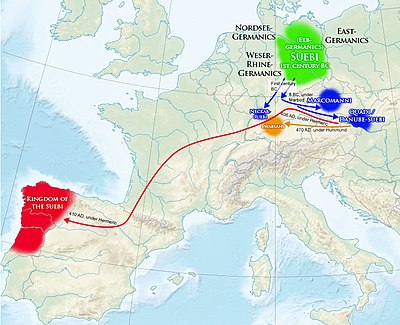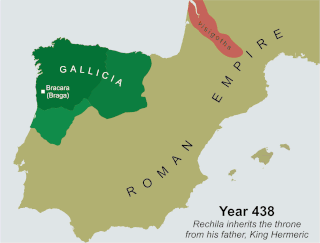
Hermeric (died 441 [1] ) was the king of the Suevi from at least 419 and possibly as early as 406 until his abdication in 438.

Hermeric (died 441 [1] ) was the king of the Suevi from at least 419 and possibly as early as 406 until his abdication in 438.

Nothing is known for sure about Hermeric before 419, the year in which he is first mentioned; namely, he became king of the Suebi (or Suevi) in the city of Braga (Bracara Augusta) according to bishop Hydatius (who wrote his chronicle around the year 470). [1] Although bishop Isidore of Seville, writing his Historia de regibus Gothorum, Vandalorum et Suevorum two centuries after the fact, claims that Hermeric was already king of the Suebi from 406, [2] Isidore based himself on primarily on Jerome, Hydatius, Prosper of Aquitaine and Orosius, none of whom mentions Hermeric prior to 419. [1]
Hermeric was a pagan and an enemy of the Roman Empire throughout his life. He is given a reign of thirty-two years in most manuscripts of Isidore of Seville's Historia Suevorum , but one manuscript does list his reign as fourteen years. [3]
According to Thompson (1982)'s interpretation of Isidore, Hermeric led the Suevi across the Rhine along with the Vandals and Alans in December 406. They crossed Gaul and the Pyrenees and settled in Hispania. [3] Kulikowski (2000 & 2015) argued that the Suebi probably stayed in northern Gaul throughout 407 to 409, and moved to Galicia between 409 and 411. [1] While Theodore Mommsen believed the Suevi were foederati and Ernst Stein seconded the notion by believing they had made an agreement with the Roman usurper Magnus Maximus whereby they received the western half of Iberia, there is no primary evidence for any alliance between the Suevi and Rome. [4] In 411 (according to Ludwig Schmidt) or 417 (according to Felix Dahn), Hermeric made a treaty with the Roman emperor Honorius, but in fact the only event of note in 411 was the division of Iberia sorte (by lot) between the barbarian peoples. [4] The east of the province of Gallaecia with its capital of Braga (Bracara Augusta) fell to the Suevi, while the west of the province went to the populous Hasdingi. [4] Between 416 and 418, the Visigoths under Wallia made war on Hermeric on behalf of Rome. [4]
In 419, after a personal dispute between Hermeric and the Vandal king Gunderic, the Vandals attacked the Suevi and trapped Hermeric in the Nervasian (Erbasian) Mountains before the Roman general Asterius intervened and the Vandals retreated. [5] Thereafter, until the Vandals left Iberia for Africa in 429, Hermeric remained peaceful, but in 430 he began to raid Gallaecia. [5]
In 431 a Gallaecian named Hydatius went to Flavius Aëtius to plead for help against the Suevi, but Aëtius delayed until 432 the sending of the comes Censorius. According to Hydatius' Chronicle of contemporary events, the Gallaecian plebs in the better-fortified strongpoints defeated Hermeric and his men, inflicting heavy casualties and taking many prisoners, which forced the Sueves to release the Gallaecian families they had taken captive (430). [6]
In 435, "on episcopal intervention", possibly Hydatius', Hermeric made peace with the Gallaecians. [7] In that same year, Hermeric negotiated through the Catholic bishop Symphosius directly with the Western Roman Emperor. [7] In 437, Censorius made a second expedition accompanied by Fretimund.
After seven years of illness, Hermeric was forced to retire from the kingship in 438 and pass it on to his son Rechila. [5] The story, recorded in Isidore, that Hermeric sent Rechila to Baetica to defeat Andevotus, Romanae militiae dux, is false, as there is no contemporary evidence that Hermeric retained any authority after his abdication. [8] There appears to have been no principle of elective monarchy among the Suevi and the successes of their raids may have accounted for the contentment of their people. [5] Hermeric's royal line lasted until 456. [9]
In 429, there appeared briefly a Suevic military leader named Heremigarius operating in Lusitania who may have been a joint monarch with Hermeric, but there is no primary source to prove it. [9]
Hermeric has been sometimes misspelled as or confused with Hermeneric in written documents. This is a quite significant issue among scholars and in academia.[ citation needed ]
The Hasdingi were one of the Vandal peoples of the Roman era. The Vandals were Germanic peoples, who are believed to have spoken an East Germanic language, and were first reported during the first centuries of the Roman empire in the area which is now Poland, eastern Germany, the Czech Republic, and Slovakia.

The Marcomanni were a Germanic people that established a powerful kingdom north of the Danube, somewhere near modern Bohemia, during the peak of power of the nearby Roman Empire. According to Tacitus and Strabo, they were Suebian.

The Suebi were a large group of Germanic peoples originally from the Elbe river region in what is now Germany and the Czech Republic. In the early Roman era they included many peoples with their own names such as the Marcomanni, Quadi, Hermunduri, Semnones, and Lombards. New groupings formed later, such as the Alamanni and Bavarians, and two kingdoms in the Migration Period were simply referred to as Suebian.
Hydatius, also spelled Idacius was a late Western Roman writer and clergyman. The bishop of Aquae Flaviae in the Roman province of Gallaecia, he was the author of a chronicle of his own times that provides us with our best evidence for the history of Hispania in the 5th century.

Gallaecia, also known as Hispania Gallaecia, was the name of a Roman province in the north-west of Hispania, approximately present-day Galicia, northern Portugal, Asturias and Leon and the later Kingdom of Gallaecia. The Roman cities included the port Cale (Porto), the governing centers Bracara Augusta (Braga), Lucus Augusti (Lugo) and Asturica Augusta (Astorga) and their administrative areas Conventus bracarensis, Conventus lucensis and Conventus asturicensis.
This is a historical timeline of the Iberian Peninsula during the period of the post-Imperial kingdoms.

The Iberian Peninsula, where Galicia is located, has been inhabited for at least 500,000 years, first by Neanderthals and then by modern humans. From about 4500 BC, it was inhabited by a megalithic culture, which entered the Bronze Age about 1500 BC. These people would become the Gallaeci, and they would be conquered by the Roman Empire in the first and second centuries AD. As the Roman Empire declined, Galicia would be conquered and ruled by various Germanic tribes, notably the Suebi and Visigoths, until the 9th century. Then the Muslim conquest of Iberia reached Galicia, although they never quite controlled the area.

Rechila was the Suevic king of Galicia from 438 until his death. There are few primary sources for his life, but Hydatius was a contemporary Christian (non-Arian) chronicler in Galicia.

Rechiar or Flavius Rechiarius was the third Suevic king of Gallaecia, from 448 until his death, and also the first one to be born in Gallaecia. He was one of the most innovative and belligerent of the Suevi monarchs. Hydatius, the contemporary bishop and chronicler from Galicia who is the sole contemporary source for biographical details of Rechiar, established his reputation as that of a barbarian with little sense of Roman law, culture, or custom; accusations already discredited, but very common at that time.
Maldras was the Suevic king of Galicia from 456 until his death. After the execution of Rechiar by the victorious Visigoths, the Suevi are said to have established Maldras on the throne. During his reign the Suevic nation became fragmented.

The Kingdom of the Suebi, also called the Kingdom of Galicia or Suebi Kingdom of Galicia, was a Germanic post-Roman kingdom that was one of the first to separate from the Roman Empire. Based in the former Roman provinces of Gallaecia and northern Lusitania, the de facto kingdom was established by the Suebi about 409, and during the 6th century it became a formally declared kingdom identifying with Gallaecia. It maintained its independence until 585, when it was annexed by the Visigoths, and was turned into the sixth province of the Visigothic Kingdom in Hispania.
Goar was a leader of the Alans in 5th-century Gaul. Around the time that the Vandals and other Alans under Respendial crossed the Rhine in 405 or 406, Goar's band of Alans quickly joined the Romans, and subsequently played a role in the internal politics of Gaul.
Censorius was a count (comes) of the Western Roman Empire from 432 until his death. He is mentioned in the Chronicle of Hydatius under the years 432 and 440.
Ajax was an Arian missionary to the pagan Suevi of Galicia who converted them to Christianity in 464 or 466.
The crossing of the Rhine River by a mixed group of barbarians which included Vandals, Alans and Suebi is traditionally considered to have occurred on the last day of the year 406. The crossing transgressed one of the Late Roman Empire's most secure limites or boundaries and so it was a climactic moment in the decline of the Empire. It initiated a wave of destruction of Roman cities and the collapse of Roman civic order in northern Gaul. That, in turn, occasioned the rise of three usurpers in succession in the province of Britannia. Therefore, the crossing of the Rhine is a marker date in the Migration Period during which various Germanic tribes moved westward and southward from southern Scandinavia and northern Germania.

Theodoric I was the King of the Visigoths from 418 to 451. Theodoric is famous for his part in stopping Attila at the Battle of the Catalaunian Plains in 451, where he was killed.

The Battle of the Nervasos Mountains occurred in the year 419 and was fought between a coalition of Suebi, led by King Hermeric together with allied Roman Imperial forces stationed in the Province of Hispania, against the combined forces of the Vandals and Alans who were led by their King Gunderic. This battle occurred in the context of a contemporary Germanic invasion of the Iberian Peninsula. The battle took place in what is today the Province of León, Spain, and resulted in a Roman/Suebian Victory.

Asterius was a Roman general who obtained the title of comes Hispaniarum in which capacity he participated in an important military expedition against the Vandals who had established themselves in the north of Gallaecia. He was also able to defeat the usurper, Maximus of Hispania who had taken refuge with the barbarian tribes there. Due to his military prowess and his considerable amount of battlefield victories, he was given the title of Patrician in 422.

This article covers the history of ancient Portugal, the period between Prehistoric Iberia and County of Portugal.